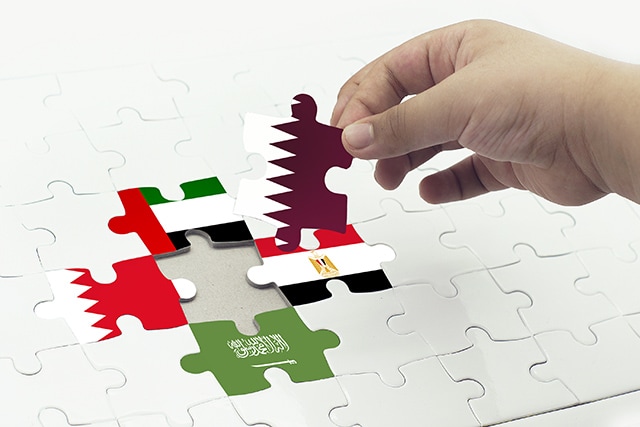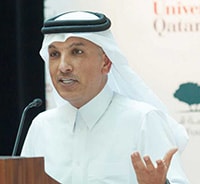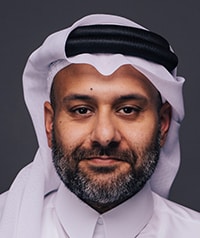Qatar, cornered by neighbors in a blockade, has since become more economically diversified and self-sufficient—and as a result, more independent.

The blockade of the small but enormously wealthy state of Qatar in June 2017 by some Gulf and neighboring countries, including Saudi Arabia, the UAE, Bahrain and Egypt, was a sharp shock to the country. However, Qatar’s economy was resilient throughout 2017 and has continued to move forward in 2018 with increased stability.
The immediate impact of the blockade was clear, through a significant halt in construction supplies and materials (mainly from Saudi Arabia), sparse supermarket shelves and the withdrawal of direct flights with the countries involved. But much of the impact has now lessened with new supply routes and business channels developed.
There was an outflow of capital deposits in the beginning of the blockade, with Qatar Central Bank and other state funds quickly injecting around US$38.5 billion of the country’s US$340 billion reserves into the economy to ease pressure on the exchange rate and cushion the impact of the disinvestment. In terms of liquidity and the Qatari riyal, the market position is sound. The Qatari economy has bounced back quickly.
Qatar has substantial hydrocarbon wealth and financial reserves, which provide it with an enormous buffer to overcome adversity. Other factors have benefited Qatar’s economy. Rising oil prices, the country’s very large infrastructure program and the relatively large workforce will continue to support nonhydrocarbon growth, which remains solid. In the hydrocarbon sector, Qatar plans to increase liquefied natural gas (LNG) production by 30% in five to seven years, cementing its position as the world’s leading exporter of LNG for the long term.
The infrastructure-investment program has helped Qatar’s growth during this challenging period. Spurred by the blockade, a renewed drive for self-sufficiency will boost investment in many sectors. Qatar’s economy has seen an acceleration of diversification over the past nine months, and investment has occurred in a number of new industries.
Drive for Independence

Qatar’s minister of finance, Ali Shareef Al Emadi, says that the blockade has created more opportunities to promote the local economy, so that Qatar’s private sector will outperform. “In the past, our policy was to avoid competition with other nations in the GCC, which created some challenges with food security and the import of medicines, among other areas. In the future, our policies will differ,” Al Emadi said at a December Euromoney conference in Qatar. “For example, we are already more than 40% self-sufficient in dairy [and] will move to 100% in the future.”
Dairy production is a pertinent example. The country had been heavily dependent on dairy products from Saudi Arabia. The blockade presented Baladna dairy an opportunity to expand the operations of its 70-hectare farm. “There were about eight different players in the Qatar dairy market prior to the blockade,” says John Dore, CEO of Baladna, “four from Saudi, one from the United Arab Emirates and two or three local players. Almost 80% of our food came from exports from these countries, and 90% of our dairy came from Saudi, so we saw the opportunity to expand and jumped at it.”
The plan got under way in July 2017, when Qatar Airways flew in 165 Holstein cows from Budapest. Over the following months the herd expanded to 4,000, as cows were flown in from locations such as Australia, the US, the Netherlands and Germany. It has since grown further. The Qatari dairy company plans to raise the number of its cows to 14,000 and meet the local demand wholly by the middle of 2018.
These initial shipments marked the launch of a new dairy industry for Qatar. Baladna farm includes 40,000 Awassi sheep, able to withstand high temperatures and known for their high-quality milk. The farm also houses around 5,000 goats. “What we’re doing here is born out of the need for food security, and the 2030 Qatar National Vision,” says Dore. “We will rear our own bulls here and enter the beef market and increase our 40,000-sheep herd as well.” The plant has advanced machinery, and Baladna’s rotary facilities are now among the best and largest in the whole of the Middle East. The company plans an IPO this year.
A Plan for Balance
To achieve balanced industrial development, the government supports industries, offering industrial incentives such as exempting establishments from fees imposed on machinery, equipment, spare parts and raw materials in order particularly to encourage small and medium-sized enterprises (SMEs). The government has also increased its focus on developing and supporting targeted industries in sectors such as the food, pharmaceutical, environmental and knowledge industries.

The results of these initial efforts have amounted to about 730 industrial establishments with investments of over 260 billion riyals (US$71.4 billion). Qatar has also given special attention to water security by establishing new desalination plants and large reservoirs for the storage of potable water.
“Qatar’s financial sector has stabilized. New ports, especially in Oman, have helped with the logistics, replacing Jebel Ali in Dubai,” Yousuf Mohamed Al-Jaida, head of the Qatar Financial Authority, told The Guardian in October. “Nothing fundamental has changed. So far we have not missed a shipment of energy.” In fact, Qatar exported more LNG in 2017 than it did in 2016.
Al Emadi notes that by the second month of the blockade, Qatar’s trade balance was back to precrisis levels. The blockade prompted the nation to shift myriad business arrangements, and now, “instead of relying on one set of countries, we have access to more than 80 countries,” he crowed in October, adding that he saw the blockade as opening up opportunities in tourism, the health sector, and food security. Al Emadi believes the economy will prove resilient because it has been ahead of other Gulf states in opening itself up to foreign investment, having invested in liquid gas, oil and gas industries and in utilities with international companies, and also in the population’s education.
Those investments continue. Qatar’s large infrastructure investment program remains undisrupted, creating the potential for new investment in the medium-to-long term, according to Ali Ahmed Al-Kuwari, group chief executive officer for Qatar National Bank (QNB), the region’s biggest bank. “New investment sectors are opening up to support self-sufficiency, such as transport and logistics, to build on the increased activity at Hamad Port; food production; tourism; and liquid natural gas, to support the proposed 30% in production,” Al-Kuwari said at the December conference. Other infrastructure projects include the development of an enhanced network of express highways and special economic zones.
Qatar’s GDP growth was 2.1% in 2017 and is forecast to rise to 2.6% in 2018. The Qatari banking sector performed well in 2017, given the conditions. Deposits rose by over 13% year-on-year, with credit growth approaching 9%. Foreign investors’ demand for Qatari assets remains good, evidenced by QNB’s recent successful inaugural A$700 million (US$564.2 million) Kangaroo bond of five- and 10-year maturity. This was followed by QNB’s US$3.5 billion three-year loan syndication in Q1 2018.
Imports increased by 28.8% year-on-year in December 2017, while exports grew 34.5% year-on-year. Foreign-exchange reserves increased to US$37.6 billion in December from US$36.9 billion in November, equating to a strong 6.5 months of import cover. Qatar’s exports surged in January 2018 due to the hydrocarbon sector, with the trade surplus up over 50% year-on-year and industrial production also improving.
Infrastructure Bonanza
Qatar’s expenditure on major projects is expected to reach about US$25 billion this year, targeting the education, health and construction sectors, in preparation for hosting the FIFA World Cup in 2022. Qatar also plans to award contracts worth US$29 billion to the private sector, in order to encourage diversification, focusing on supporting food security projects, SMEs and the development of infrastructure in economic and free-trade zones.
Hamad Port will play a major role in developing the economy’s next phase, as it is one of the biggest and newest ports in the Middle East. Agreements have been signed with important shipping lines to link Hamad Port with international ports in Turkey, China, Taiwan, Oman, Australia, Pakistan, Singapore and Kuwait.
Many of the country’s projects are in line with Qatar National Vision 2030 goals and nationwide development principles to diversify the economy. Vision 2030 aims to transform the country into a knowledge-based economy. The FIFA World Cup has generated huge activity on a wide range of projects, such as highways, stadium construction and general infrastructure projects. The massive Doha Metro transport system is taking shape, with the first phase expected to begin operations in 2020. The Lusail Tram system is another major project. Some of the projects have seen a slight delay, but Qatar has the resources to expedite progress. Investment spending and population growth have provided a boost to domestic demand and growth in the nonhydrocarbon sector, as the economy diversifies away from oil and gas.
Domestic banks are capitalizing on new opportunities. As well as financing principal projects, large banks such as QNB are involved with many other underlying projects related to utilities, transport and infrastructure—including water, power, sewerage, vessels, aircraft and rail projects throughout the country.
Government support to private-sector initiatives is encouraging local production of goods. Transportation and logistics firms will gradually benefit through an increase in trade volumes arriving directly in Qatar at the new Hamad Port. As a direct result of the blockade, Qatar has seen significant growth in the SME area across a range of sectors, from manufacturing and food through education and health. Qatar has found new trading partners, has diversified private-sector supply and redirected trade routes. The state’s response to the blockade has been proactive by initiating projects focused on long-term economic self-sufficiency and sustainability within the private sector.
Far from holding back the state, the blockade has helped energize Qatar in the pursuit of self-sufficiency and ensure sustainability of the local economy.



